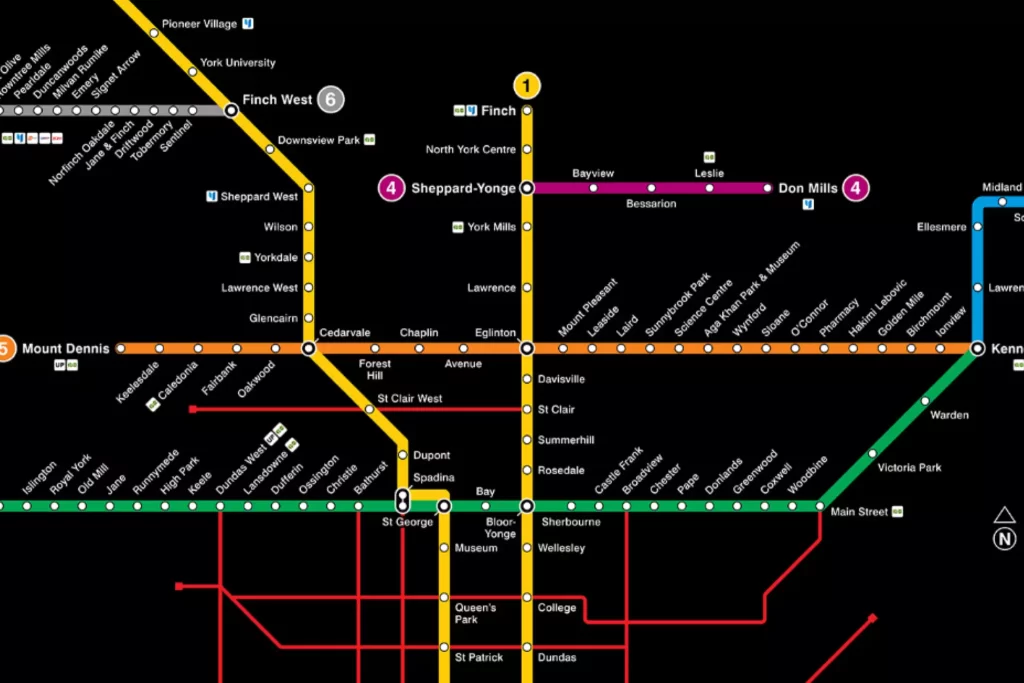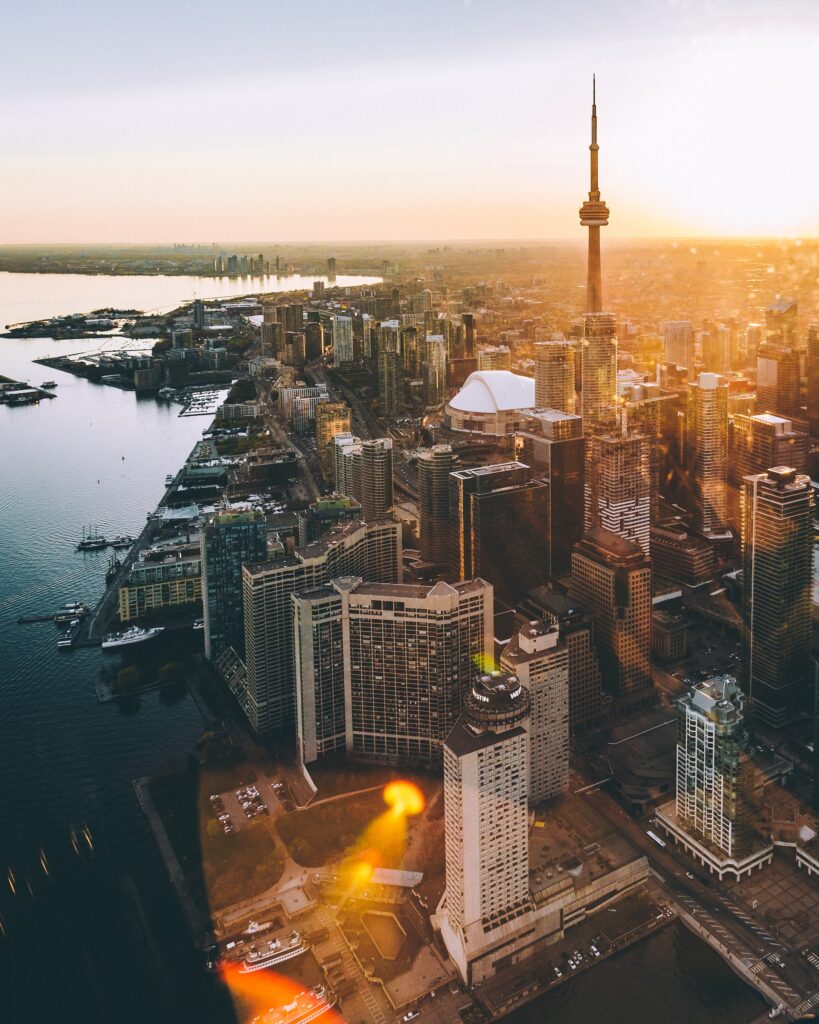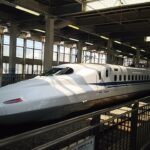The Toronto Transit Commission provides public transit in Toronto (TTC). In the entire city, the TTC runs a huge network of buses, streetcars, and subways. In addition, there are other private transit providers in Toronto, such as GO Transit, UP Express, and TTC services. A single adult fare is available under the TTC fare structure, and it is good for one ride on any TTC service, transfers included. Numerous bike lanes and bike-sharing programs are available in Toronto, giving locals and visitors an additional mode of transportation.
Basic information about the Metro system in Toronto
With more than 5 million daily riders, the Toronto metro is the third-largest rapid transit system in North America. The system consists of three light rail transportation lines, more than 75 bus routes, and four subway lines, of which two are currently under construction (Line 5 – Eglinton and Line 6 – Finch West). The bus routes cover places that the subway does not directly service and the metro’s 75 km of lines. The city’s 69 metro stations and more than 12,000 bus stops make it simple for residents to move about. A quick, dependable, and efficient way to get around the city is to use the Toronto metro system.
The lines of the Toronto subway system
One of the biggest and most dependable public transit networks in the world is the subway in Toronto. There are four rapid transit lines, two hybrid commuter rail lines, and one light rail line in the subway system in Toronto. With almost 1.76 million daily riders, it is North America’s third-largest subway system.
Four main lines make up the Toronto Subway network, all of which pass through Downtown Toronto and its environs. The Yonge-University-Spadina Line (Line 1), which connects Union Station in the south with Finch Station in the north, is the first line. With over 800,000 passengers riding this line on average during the weekdays, it is the busiest in the entire system. Along its course, Line 1 also provides service to York University and the University of Toronto.
The Bloor-Danforth Line (Line 2), which connects Kennedy Station in the east with Kipling Station in the west, is the second line. This line goes to a lot of important places, like the Toronto Zoo, Scarborough Town Center, and the Bloor-Yonge intersection. With an average weekday rider count of more than 600,000, Line 2 is the longest line in the system.
The Scarborough Line (Line 3), which connects Kennedy Station in the east with McCowan Station in the west, is the fourth line. This line goes to many important places, like Centennial College, the Scarborough Town Centre, and the Scarborough Civic Centre. On a weekly basis, over 200,000 people use Line 3.
The Sheppard Line (Line 4) is the third line, and it connects Don Mills Station in the south with Sheppard-Yonge Station in the north. This line goes to many important places, like the Ontario Science Centre, Fairview Mall, and Scarborough Town Centre. Over 400,000 people take Line 4 on a typical daily.
In addition to the four core lines, the Toronto Subway system has two hybrid commuter rail lines, the GO Transit Lakeshore East and West Lines, and one light rail line, the Scarborough Rapid Transit Line. These routes go to a lot of important places, like Pearson Airport, Union Station, and the Ontario Science Centre.
The subway system in Toronto is a safe and efficient way to get around the city and its surroundings. It is simple to go to practically any location in the city because of its large network of lines. The Toronto Subway system can get you where you need to go, whether you’re going to work, school, or just for pleasure.
Map of Toronto Metro 2023 – Free Download in PDF

Now you may download the Metro Map of Toronto 2023 for free in PDF format! This comprehensive and accurate map displays every station, route, and attraction in Toronto. It’s the ideal tool for getting around town and organizing your next adventure. Also, it is easy to use and can be printed or saved on a device so that it is easy to get to. Get your free copy of the Metro Map of Toronto 2023 right away to make exploring the city simpler and more fun!
Public transport tickets in Toronto – Best types for travelers & actual prices
Toronto, which is the largest city in Canada, has a huge public transportation system that connects all of the city’s different neighborhoods. Passengers must buy tickets or passes that can be used on buses, streetcars, and the subway in order to use the public transit system. The type of ticket and how much it costs depend on how far you’re going and how you’re getting there.
The most basic sort of ticket, single-ride tickets, are only good for one trip on one mode of transportation. A single-ride ticket’s cost will vary according to the route taken and the mode of transportation. For instance, a single subway ride costs $3.25, while a single bus or streetcar ride costs $3.00.
A day pass can be purchased if the user plans to take the public transportation system more than once. Day passes can be used as much as you want on buses, streetcars, and the metro for the whole day. A single-day pass costs $12.50.
A monthly pass can be purchased if a traveler plans to regularly use public transit. For the duration of the month, a monthly pass is good for unlimited use on buses, streetcars, and the metro. A month-long pass costs $146.25.
In addition to the regular tickets and passes, there are also tickets and passes that are made just for certain groups. Discounted rates are available to students, older citizens, and those with disabilities. To get a lower fare, seniors and people with disabilities must show proof of their age or disability. Students must show a valid student ID card.
Two additional special passes are available from the Toronto Transit Commission (TTC), which can be used for unlimited travel on specific days of the month. Up to two adults and four children may travel for less with the Family/Group Pass. Travel is unrestricted on Saturdays, Sundays, and legal holidays using the Weekend Pass costing $11.50 each.
Public transportation tickets and passes can be bought at TTC ticket machines, TTC Customer Service Centers, and a few stores and convenience stores. Credit cards, debit cards, and cash are all accepted. In Toronto, using the public transportation system is an easy and cost-effective way to travel the city. Passengers can select the best ticket type and price for their needs from a variety of options.
Summary of fares for public transport in Toronto
- Single-ride subway and bus fares are $3.00 and $3.25, respectively.
- Day passes cost $12.50 and are good for unlimited use on buses, streetcars, and the metro.
- Monthly passes cost $146.25 and are good for unlimited use on buses, streetcars, and the metro.
- Special passes are available for unrestricted travel on certain days of the month.
- Discounted rates are available for students, senior citizens, and people with disabilities.
Timetables & Schedules of the Toronto Metro system
A practical, dependable, and user-friendly public transit system is the Toronto Metro system. The Metro is open every day of the week, from 6 a.m. to 1 a.m. on weekdays and 8 a.m. to 1 a.m. on weekends. All trains operate every five minutes or less during peak hours and every ten minutes or fewer at all other times on the Metro, which consists of subway, streetcar, and bus services. Additionally, the Metro provides an Express Service on the subway lines, which operates every 20 minutes on weekdays and every 10 minutes during the day. The Express Service allows users to get to their destinations more quickly. You can choose from a number of routes on the Toronto Metro system to reach where you need to go.
What Are Other Options for Public Transportation in Toronto?
In Toronto, using the public transit system is essential for getting around, and many people like the metro as one of their options. However, there are a number of additional options that provide different routes for getting around the city. Let’s examine some of Toronto’s other public transportation choices.
Buses – The population is served by a network of buses that travels throughout the city of Toronto. The Toronto Transit Commission (TTC) has a variety of bus routes that travel through different regions. The TTC also offers low-floor bus service, and many buses are handicapped accessible. This makes navigating the city with a wheelchair or other mobility device simpler.
Streetcars – The TTC runs a network of streetcars that provide transportation across Toronto. Streetcars run on a lot of different lines and make it easy to get around the city. Low-floor streetcars are accessible for wheelchair users and are offered on some routes.
Taxis – Taxis are another method of transportation in Toronto. Taxis are offered at taxi stands and can be reserved over the phone or online. For people who need to go somewhere fast but cannot use public transportation, taxis are a useful option.
Ridesharing – In Toronto, ridesharing services like Uber and Lyft are becoming more and more well-liked. With the help of these services, users may arrange a ride with a driver who will take them where they need to go. Rideshare services can be swiftly and easily scheduled through an app, and they are frequently less expensive than taxis.
Cycling – A terrific method to get around Toronto is by bicycle. Bicyclists can easily move throughout the city because to its network of bike lanes and paths. With so many beautiful routes to choose from, cycling is another fantastic way to see the city.
Walking – Another excellent method of getting around Toronto is by foot. The city has many walkways, and many locations are welcoming to pedestrians. A terrific way to see the city and get some exercise at the same time is by walking.
As you can see, Toronto offers a variety of public transit options besides the subway. There is something for everyone, whether you want a rapid ride or a leisurely stroll.
How to Take Public Transportation From Billy Bishop Toronto City Airport (YTZ) to the City Center
Public transportation is a quick and convenient option for visitors to go from Billy Bishop Toronto City Airport (YTZ) to the city core. Step-by-step directions on how to easily go from the airport to the city center are provided in this guide.
The first step is to board the free shuttle bus that operates every 15 minutes from the airport to the mainland. The shuttle will get you to the main terminal of the airport, from which you can access the Toronto Transit Commission (TTCnetwork’s ) of public transit.
There are a few ways to travel to the city center from the main terminal. The 509 Harbourfront streetcar runs every few minutes, so you can take it to get to Union Station in the heart of Toronto. As an alternative, you can ride the 511 Bathurst streetcar, which travels to Bathurst Station around every ten minutes. From the main terminal, one may access both of these streetcar routes. You can take the 6 Bay bus from the main terminal to Union Station or the 121 Fort York-Esplanade bus to King Street West & Spadina Avenue if you’d like to go by bus. You may get to the city center using any path.
The Billy Bishop Toronto City Airport is easy to get to by public transportation from the city center. You’ll be able to reach the city’s centre easily and swiftly with the help of this guide.
What kinds of sights should you see if you’re visiting Toronto for the first time?
Toronto is the largest city in Canada. It is known for its great tourist spots, diverse culture, and busy entertainment scene. It can be challenging to choose which attractions to visit first when there is so much to see and do. Here is a list of the top Toronto attractions to make your decision easier.
One of Toronto’s most iconic landmarks is the CN Tower, which rises to a towering 553.33 meters in height. The tower features an observation deck with breathtaking views, the highest glass floor in the world, as well as a choice of food and entertainment options.
Ripley’s Aquarium of Canada is a beautiful underwater world with more than 16,000 aquatic animals from 450 species. It is in the middle of Toronto. Visitors can see the wonders of the ocean and learn about conservation initiatives while seeing anything from sharks and jellyfish to seahorses and marine turtles.
Kensington Market is a bustling, diverse neighborhood in the center of Toronto that is home to a variety of interesting stores, eateries, and cafes. This pedestrian-friendly market is a wonderful location to discover Toronto’s rich cultural diversity, savor delectable cuisine, and hunt for one-of-a-kind treasures.
With a collection of more than 6 million items and artifacts, the Royal Ontario Museum is one of the biggest in North America. From dinosaurs to ancient treasures, the museum has a wide range of interesting exhibits, galleries, and educational programs.
The Toronto Islands are a peaceful haven in the city and are only a short ferry trip from downtown Toronto. The islands are a great place to relax and take in the gorgeous views of Lake Ontario because they have many parks, beaches, and other places to play.
Toronto’s largest public park, High Park, offers a wonderful getaway from the activity of the city. People can walk around the well-known Grenadier Pond, check out the park’s many paths and gardens, and look for animals.
These are but a few of Toronto’s best tourist destinations. Toronto has something for everyone, whether you’re seeking culture, entertainment, or relaxation. So make sure you take advantage of everything the city has to offer!
Summary of our tour guide for Toronto
Toronto, which is in Canada, is a thriving, multiethnic city with a diverse population and a wide range of cultural attractions. Buses, trains, streetcars, and subways are all part of the city’s effective public transportation system. The Toronto Transportation Commission (TTC) runs the biggest bus, streetcar, and subway system in the nation as well as is the city’s major transit provider. The TTC is a convenient way to get around the city at a reasonable price, and it can be used to connect to other forms of public transportation. Additionally, the city offers bicycle rentals as a substitute for its public transportation system. Thanks to its top-notch attractions and public transportation system, Toronto is a great place to visit if you want to see and enjoy the best the city has to offer.
Top 5 FAQs and answers about Toronto public transport?
- What kinds of public transportation are offered in Toronto?
- Transit options in Toronto include streetcars, subways, and buses. Additionally, there are light rail transit systems, above-ground trains, and services for people with disabilities. The Toronto Transit Commission (TTC) is the main company that runs public transportation in the city.
- How much does it cost to go in Toronto using public transportation?
- Depending on the service you take, public transportation in Toronto varies in price. The TTC’s single adult fare is $3.25. Discounted day and weekly passes are also available.
- How can I pay for Toronto’s public transportation?
- Cash, credit cards, and tokens can all be used at the TTC. The most economical way to pay for single adult fares is with tokens. Tokens are available for purchase at all TTC stations and certain convenience stores.
- What other options do I have for transportation?
- There are alternative ways to get about Toronto if you don’t want to take public transportation. In addition to having designated bike lanes on several streets, the city maintains a bike-sharing scheme. Additionally, you can make use of ride-sharing services like Uber or Lyft.
- Is Toronto’s public transportation secure?
- In general, Toronto’s public transportation is quite secure. Security cameras and frequent patrols are just two of the security precautions the TTC has put in place. You can call the TTC’s customer service line if you ever feel uneasy while travelling by public transportation.
Useful links







